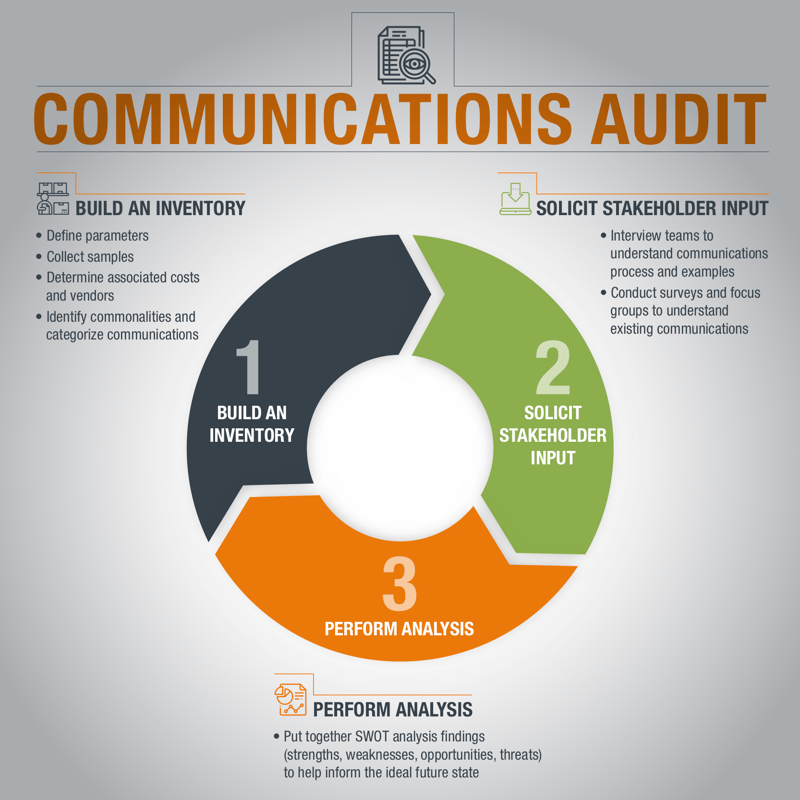Most advisory firms have accumulated years of client communications, pitch decks, brochures, and website content that nobody has reviewed in ages. Sound familiar? At a certain point, putting off a communications audit can put your business at risk. Here is what to know and how to get it done.
Why Your Financial Advisory Firm Needs a Communications Audit
A communications audit helps you identify what's working, what's not, and where the opportunities lie to better connect with clients and prospects. For financial advisors specifically, this process is practically required given compliance guidelines and regulations.
Plus, since your business is trust-based, you have to make sure that every potential and current client is never faced with contradictory messaging that could lead to confusion and frustration.
What Exactly Is a Communications Audit?
A communications audit is the process of identifying and analyzing all of the messages that your advisory firm sends internally and externally through its various communication vehicles. This may include, but is not limited to, your website, emails, internal communication platforms, and the firm’s social media pages. While conducting such an audit takes time (and yes, sometimes feels like organizing that closet you've been avoiding), it provides significant benefits:
1. Brand Consistency and Compliance Protection
As your firm grows, content ownership changes and communications spread across various locations. This creates both branding inconsistencies and potential compliance risks.
Consistent evaluation lets you update or retire outdated resources while alerting your team to new, compliant resources. Your firm's story should be the same whether a prospect finds you on LinkedIn or receives your quarterly newsletter.
2. Spotting Gaps and Eliminating Waste
By reviewing all content, you'll find which communications are working and which aren't worth the effort. We've worked with RIAs sending multiple market updates to clients, only to discover through an audit that just one format had meaningful engagement.
A holistic view helps you move from "random acts of marketing" to messaging that resonates with clients and prospects.
3. Aligns Communications with Compliance Requirements
An audit ensures that all content is included in your communications inventory. From there, you can develop a regular schedule for review by various stakeholders, subject matter experts, and compliance officers.
For financial advisory firms, this is particularly important given SEC and FINRA requirements. Planning and allocating time for review helps guarantee that material is not only relevant but also compliant to avoid costly mistakes.
Common Communications Challenges for Financial Advisory Firms
Before you make the plunge into the audit process, it's worth noting the communications headaches that many advisory firms face, so you know what you or your outsourced marketing agency should be looking for:
Content Drift: Over the years of operation, messaging often drifts from its original intent as different team members create materials. Without regular review, your firm's positioning can feel like that patchwork quilt you made in grade school.
Regulatory Changes: The financial industry's regulatory landscape evolves constantly. Older compliant materials may not meet current standards.
Target Audience Evolution: As your firm grows, your ideal client profile may change. For example, communications created for older generations could miss the mark if you’re now targeting Millennials or even Gen Z.
Digital Transformation: Many firms still rely on legacy print materials while clients increasingly expect online communications. An audit can highlight where your communication methods might be outdated.
How to Conduct a Communications Audit in 3 Steps
- Prep: Create the Inventory Template - Develop a spreadsheet to track all communications pieces, their purpose, audience, and owners. Collect everything from email templates to social media content to printed brochures, and estimate the associated cost and vendors needed for the audit.
- Stakeholder Input - Assess materials for alignment with your firm's current value proposition and brand voice. This may include conducting interviews and focus groups to understand communication processes and potential issues.
- SWOT: Evaluate the Effectiveness - Assess which communications drive engagement and which fall flat by identifying Strengths, Weaknesses, Opportunities, and Threats (SWOT) through an in-depth analysis.

When Should You Conduct a Communications Audit?
Knowing how to perform a successful review of your communications is useless unless you also know when to get it done.
The best time to conduct an audit is:
- After significant firm changes (mergers, acquisitions, or rebranding)
- When bringing on new advisor teams
- During annual business planning
- When you notice inconsistent messaging across channels
- If client engagement metrics are declining
A good rule of thumb is every 12-18 months, with mini-reviews quarterly. This cadence helps maintain messaging consistency without overwhelming your team (or your budget).
From Audit to Action: Transforming Client Communications
Conducting a communications audit allows your advisory firm to assess its current communication practices, course correct, and discover areas of opportunity. In an industry where trust and relationships are everything, clear and consistent communications can give you the edge.
We've helped many financial advisory firms transform their client communications from compliance-driven necessities to powerful relationship-building tools. To chat through your firm's communication strategy and how Craft Impact can facilitate your communications audit (and the other marketing stuff), plus next steps, get in touch.

